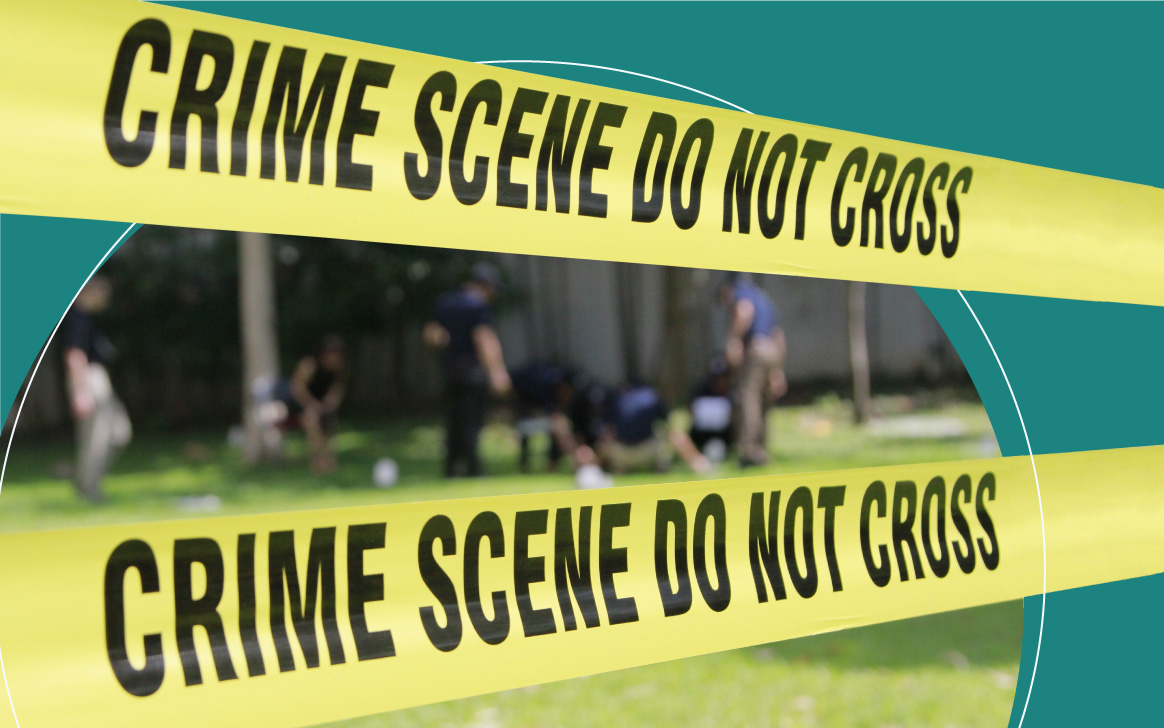The 45 most dangerous college campuses 2024

Search Online Programs
www.degreechoices.com is an advertising-supported site. Featured or trusted partner programs and all school search, finder, or match results are for schools that compensate us. This compensation does not influence our school rankings, resource guides, or other editorially-independent information published on this site.
We analyzed data from the U.S. Department of Education to create a list of the 45 most dangerous colleges.
We examined violent crimes reported on 10,499 college campuses in 2022 (the latest set of data).
We list the 45 college campuses with the highest numbers of violent crimes that year.
In 1986, 19-year-old Jeanne Clery was raped and murdered in Stoughton Hall at Lehigh University in Bethlehem, Pennsylvania. It was one of 38 violent crimes that occurred on that campus in three years. Her parents sued the university and argued that if they had been aware of the number of crimes on campus, their daughter wouldn’t have attended. They won the case, and in 1990, the Clery Act was signed.
The Clery Act requires all colleges and universities that participate in federal aid programs to report crimes on or around their campuses annually.
To create the list of most dangerous college campuses, we looked at violent crime data at 10,499 universities across America reported in 2022.
Why are these the most dangerous colleges?
We used Campus Safety and Security data reported to and published by the U.S. Department of Education to analyze violent crimes on campus at public, private, and non-profit universities. We selected colleges with a minimum institution size of 500 students with or without on campus housing.
The colleges listed have the highest numbers of violent crimes on campus in 2022.
In 2019 alone, a total of 27,300 criminal incidents of the following types were reported to police and security agencies:
2019 criminal incidents
PieChart Data
enter in the editor the amount of columns you want to show
and their values.
Earn a degree from the safety of your home
www.degreechoices.com is an advertising-supported site. Featured or trusted partner programs and all school search, finder, or match results are for schools that compensate us. This compensation does not influence our school rankings, resource guides, or other editorially-independent information published on this site.
What is a violent crime?
A violent crime involves the use of force or threat of force against a person. According to the FBI, violent crimes are:
- Rape
- Murder/manslaughter
- Aggravated assault
- Robbery
These crimes are defined as follows by Campus Safety and Security:
- Rape – The penetration, no matter how slight, of the vagina or anus, with any body part or object, or oral penetration by a sex organ of another person, without the consent of the victim.
- Murder/non-negligent manslaughter – The willful (non-negligent) killing of one human being by another.
- Negligent manslaughter – The killing of another person through gross negligence.
- Robbery – The taking or attempting to take anything of value from the care, custody, or control of a person or persons by force or threat of force or violence and/or by putting the victim in fear.
- Aggravated assault – An unlawful attack by one person upon another for the purpose of inflicting severe or aggravated bodily injury. This type of assault usually is accompanied by the use of a weapon or by means likely to produce death or great bodily harm.
To create the list of most dangerous colleges we did not consider general criminal offences, arrests, domestic violence, fondling, stalking, dating violence, hate crimes, or any other type of crime the U.S. Department of Education categorizes as a VAWA (Violence Against Women Act) crime aside from the violent crimes listed above.
Violent crime on college campuses
Because many universities own and operate properties around their main campuses, we focused on violent crimes committed on campus only.
Campus Safety and Security defines on campus as, “A reasonably contiguous geographic area comprising of buildings or properties that are owned or controlled by an institution and utilized for educational purposes, including residence halls.”
It also includes any building or property that is owned by the university but controlled by another person, frequently used by students, and supports institutional purposes (such as a food or retail vendor).
What did we leave out?
As part of the Clery Act, postsecondary institutions are required to merge statistics from their own records with those of local law enforcement agencies and then report these under the relevant categories for on-campus, non-campus, and public property.
Because we want this article’s focus to be on the most dangerous college campuses, we omitted violent crimes that were considered non-campus and public property.
Disclaimer: Remember that some colleges may be underreporting crime statistics, while others are highly transparent. Even official statistics should be taken with a grain of salt.
The most dangerous college campuses
| University name | Number of violent crimes reported in 2022 |
|---|---|
| 1. Ohio State University, Main Campus | 111 |
| 2. University of California, Berkeley | 105 |
| 3. University of Arizona | 95 |
| 4. University of New Mexico, Main Campus | 89 |
| 5. University of Michigan, Ann Arbor | 78 |
| 6. Texas A & M University, College Station | 64 |
| 7. Texas State University | 64 |
| 8. Stanford University | 55 |
| 9. University of Iowa | 54 |
| 10. Pennsylvania State University, Main Campus | 53 |
| 11. University of Southern California | 50 |
| 12. Yale University | 49 |
| 13. Indiana University, Bloomington | 48 |
| 14. Indiana University-Purdue University, Indianapolis | 48 |
| 15. University of Nebraska, Lincoln | 47 |
| 16. University of Cincinnati, Main Campus | 46 |
| 17. University of Minnesota, Twin Cities | 45 |
| 18. University of California, Davis | 44 |
| 19. The University of Alabama | 43 |
| 20. University of Kentucky | 43 |
| 21. University of California, Santa Barbara | 41 |
| 22. University of Virginia, Main Campus | 41 |
| 23. University of North Carolina at Chapel Hill | 39 |
| 24. Eastern Michigan University | 38 |
| 25. Texas Tech University | 38 |
| 26. The University of Texas at Austin | 38 |
| 27. Vanderbilt University | 38 |
| 28. Miami University, Oxford | 37 |
| 29. Western Washington University | 37 |
| 30. University of Pittsburgh, Pittsburgh | 36 |
| 31. University of Wisconsin, Madison | 36 |
| 32. Northern Arizona University | 35 |
| 33. University of Florida | 35 |
| 34. Prairie View A & M University | 33 |
| 35. Arizona State University | 32 |
| 36. Colorado State University, Fort Collins | 32 |
| 37. Grand Canyon University | 32 |
| 38. Rutgers University, New Brunswick | 32 |
| 39. San Jose State University | 32 |
| 40. Tulane University of Louisiana | 32 |
| 41. University of Kansas | 32 |
| 42. West Virginia University | 32 |
| 43. The University of Tennessee, Knoxville | 31 |
| 44. Bowie State University | 30 |
| 45. University of California, Irvine | 30 |
Disclaimer: The above list of most dangerous campuses uses the absolute number of violent crimes without taking into account relative campus size.
Underreporting or not reporting campus crime
According to our research, of the 10,499 campuses we analyzed, 9,312 reported 0 incidents of rape. This means in 2022 88.7% of all institutions reported 0 incidents of rape on their campuses.
However, research published by the American Psychological Association indicated that during Department of Education audits, the reported instances of sexual assault increased by an average of 44%.
This suggests that some institutions offer a more accurate representation of on-campus assaults only when subjected to federal oversight.
Key findings from our research
- Of the 10,499 campuses we analyzed 8,923 reported 0 incidents of violent crime. This is 85% of all campuses.
- Of the 10,499 campuses we analyzed 720 reported 1 or 2 incidents of rape. This means 95.6% of all institutions are reporting 2 or fewer incidents of rape.
- Of the 4-year universities that reported 0 crimes while having student bodies of over 5,000 43.6% were private, private non-profit, or private for-profit universities, 53.1% were public universities, and 14.8% had religious affiliations.
- Out of the top 200 schools with the most on campus crime, the states with the most schools present were: California, Texas, North Carolina, New York, and Pennsylvania.
Most dangerous campuses per 100,000
As stated above, we didn’t factor institution size in our listing of the most dangerous colleges above. The following list contextualizes the numbers of violent crimes according to institution size.
| University name | Number of violent crimes on campus per 100,000 students* |
|---|---|
| 1. Brookline College, Albuquerque | 3,977 |
| 2. Cox College | 2,347 |
| 3. Transylvania University | 1,941 |
| 4. Millsaps College | 1,664 |
| 5. Burrell College of Osteopathic Medicine | 1,511 |
| 6. Hobart William Smith Colleges | 1,431 |
| 7. Mayo Clinic College of Medicine and Science | 1,374 |
| 8. East Georgia State College | 1,281 |
| 9. Chowan University | 1,242 |
| 10. University of Massachusetts Chan Medical School | 1,183 |
| 11. Westminster College | 1,148 |
| 12. Haskell Indian Nations University | 963 |
| 13. Langston University | 893 |
| 14. St. Mary’s College of Maryland | 855 |
| 15. Spartanburg Methodist College | 846 |
| 16. Louisiana State University Health Sciences Center-Shreveport | 788 |
| 17. Lawrence University | 771 |
| 18. Harvey Mudd College | 759 |
| 19. Gallaudet University | 756 |
| 20. Franklin and Marshall College | 754 |
| 21. Milwaukee School of Engineering | 733 |
| 22. Dickinson College | 702 |
| 23. Lees-McRae College | 702 |
| 24. Jarvis Christian University | 686 |
| 25. Randolph-Macon College | 671 |
| 26. SUNY Morrisville | 666 |
| 27. Bridgewater College | 633 |
| 28. Earlham College | 591 |
| 29. Hampshire College | 591 |
| 30. Dean College | 589 |
| 31. Maryland Institute College of Art | 564 |
| 32. Middlebury College | 563 |
| 33. University of Minnesota-Morris | 562 |
| 34. Defiance College | 556 |
| 35. Harris-Stowe State University | 554 |
| 36. Spokane Falls Community College | 553 |
| 37. Roger Williams University School of Law | 543 |
| 38. Randolph College | 542 |
| 39. Albert Einstein College of Medicine | 537 |
| 40. Brevard College | 527 |
| 41. St Olaf College | 525 |
| 42. The Evergreen State College | 523 |
| 43. The College of Wooster | 508 |
| 44. Saint Michael’s College | 500 |
| 45. Lincoln University | 493 |
Rape on college campus statistics
In 2019, forcible sex offenses (rape and fondling) accounted for 43% of all criminal incidents. According to RAINN, only 20% of female students aged 18-24 report sexual assault to law enforcement.
When looking at the most dangerous colleges on our list, rape accounts for 64.4% of the total violent crime we analyzed. This is a 4% rise from our 2023 analysis.
The following schools have an above-average percentage of rapes on campus out of total violent crimes. A few of these universities are not on the list for most dangerous colleges above, but they exceeded the average for rape and are therefore included here.
Percentage of rape out of total violent crimes on campus
PieChart Data
enter in the editor the amount of columns you want to show
and their values.
Why is campus safety important?
Campus safety is important for protecting the well-being of those who study, work, and visit there, and for creating a safe environment for all students, faculty, and staff. Most campuses have campus police, security, emergency services, and counseling services for students and staff to ensure campus safety.
What schools are doing about campus safety
Campus safety is a priority for the vast majority of college campuses. Criminal activity and the looming threat of active shooters on campus are taken very seriously. Universities work from many different angles to ensure people are safe on their campuses.
 Mobile phone apps
Mobile phone apps
The University of Tampa’s Spartan SOS app allows users to connect with the Department of Campus Safety without having to remember Campus Safety phone numbers or even unlock their phone. Anonymous tips can also be sent through the app.
 Campus crime publications
Campus crime publications
Some schools offer online publications, like the Berkeley Scanner, where students can read about crimes in real time. UC Berkeley is third on our list of most dangerous college campuses. This publication gives students insight into what is going on in and around campus.
 Active shooter security measures
Active shooter security measures
In the wake of the February 13th mass shooting at Michigan State, new security measures are being introduced on campus. This includes additional security cameras throughout campus, keycards for entering campus buildings, lock systems on classroom doors, and starting this fall students, faculty, and staff will need to complete active violence intruder training.
Conduct your own safety analysis
High rates of violent crime or a history of covering up violent crime are why universities made this list of most dangerous colleges. The Clery Act was signed to ensure students and parents can access the information needed to take safety into account before choosing a college.
When looking at which college to attend, learn more about a campus’ crime rate by conducting your own Campus Safety and Security analysis.
Additional resources
Caters specifically to individuals in North America who hold positions of responsibility for public safety, security, and emergency management on educational and healthcare campuses.
The Clery Center collaborates with college and university communities to establish safer campuses, making it the go-to resource for institutions seeking guidance on campus safety regulations.
The Rape, Abuse & Incest National Network (RAINN) is the biggest organization in the country dedicated to combating sexual violence. In addition to its efforts to prevent sexual violence, RAINN also provides assistance to survivors and works to ensure that those who commit these crimes are held accountable.
The National Organization for Victim Assistance connects victims with services and resources, provides skill-based training, works with crime victims through credentialing programs, and promotes public policy initiatives.
FAQ
What percentage of college men will be the victim of sexual assault?
2.5% of males experience rape or sexual assault through physical force, violence, or incapacitation. Male college-aged students (18-24) are 78% more likely than non-students of the same age to be victims of rape or sexual assault.
What percentage of women are sexually assaulted in college?
Among undergraduate students, 26.4% of females (compared to 6.8% of males) become victims of rape or sexual assault through physical force, violence, or incapacitation.
When are students at a higher risk for sexual assault?
Students are at an increased risk during the first few months of their first and second semesters at college. More than 50% of college sexual assaults occur between August and November.
www.degreechoices.com is an advertising-supported site. Featured or trusted partner programs and all school search, finder, or match results are for schools that compensate us. This compensation does not influence our school rankings, resource guides, or other editorially-independent information published on this site.




